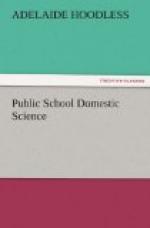CHAPTER I.
The Relation of Food to the Body.
In order to understand the relation of food to the sustenance and repairing of the body, it will be necessary to learn, first, of what the body is composed, and the corresponding elements contained in the food required to build and keep the body in a healthy condition. The following table gives the approximate analysis of a man weighing 148 pounds:—
Oxygen 92.1 pounds. Hydrogen 14.6 " Carbon 31.6 " Nitrogen 4.6 " Phosphorus 1.4 " Calcium 2.8 " Sulphur 0.24 " Chlorine 0.12 " Sodium 0.12 " Iron 0.02 " Potassium 0.34 " Magnesium 0.04 " Silica ? " Fluorine 0.02 " ------ Total 148.00 pounds.
As food contains all these elements, and as there is constant wearing and repair going on in the body, it will be readily seen how necessary some knowledge of the relation of food to the body is, in order to preserve health.
Hydrogen and oxygen combined form water, hence we find from the above calculation that about three-fifths of the body is composed of water. Carbon is a solid: diamonds are nearly pure carbon; “lead” of lead pencils, anthracite coal and coke are impure forms of carbon. Carbon combined with other elements in the body makes about one-fifth of the whole weight. Carbon with oxygen will burn. In this way the carbon taken into the body as food, when combined with the oxygen of the inhaled air, yields heat to keep the body warm, and force—muscular strength—for work. The carbonic acid (or carbon dioxide) is given out through the lungs and skin. In the further study of carbonaceous foods, their relation to the body as fuel will be more clearly understood, as carbon is the most important fuel element. Phosphorus is a solid. According to the table, about one pound six ounces would be found in a body weighing 148 pounds. United with oxygen, phosphorus forms what is known as phosphoric acid; this, with lime, makes phosphate of lime, in which form it is found in the bones and teeth; it is found also in the brain and nerves, flesh and blood. Hydrogen is a gas, and like carbon unites with the oxygen of the inhaled air in the body, thus serving as fuel. The water produced is given off in the respiration through the lungs and as perspiration through the skin.[3] Calcium is a metal. The table given allows three pounds of calcium; united with oxygen, calcium forms lime. This with phosphoric acid makes phosphate of lime, the basis of the bones and teeth, in which nearly all the calcium of the body is found.




